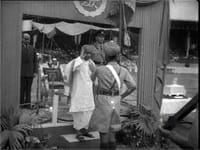One of the world's largest Paramilitary forces responsible for a variety of internal security and law enforcement tasks in India
 The Central Reserve Police Force (CRPF) is the premier central police force the Union of India entrusted with maintaining internal security. Established originally as the Crown Representative's Police in 1939, it stands as one of the oldest central paramilitary forces. The CRPF's formation was a response to escalating political turmoil and unrest within the princely state of India, spurred by the Madras Resolution of the All-India Congress Committee in 1936. This development aligned with the Crown Representative's growing aspiration to aid numerous native states in upholding law and order, in line with imperial policy.
The Central Reserve Police Force (CRPF) is the premier central police force the Union of India entrusted with maintaining internal security. Established originally as the Crown Representative's Police in 1939, it stands as one of the oldest central paramilitary forces. The CRPF's formation was a response to escalating political turmoil and unrest within the princely state of India, spurred by the Madras Resolution of the All-India Congress Committee in 1936. This development aligned with the Crown Representative's growing aspiration to aid numerous native states in upholding law and order, in line with imperial policy.
 Post-independence, on December 28, 1949, the organization underwent a name change through an Act of Parliament and was renamed as the Central Reserve Police Force. This legislative action also established the CRPF as an armed entity under the jurisdiction of the union. Sardar Vallabh Bhai Patel, who held the position of Home Minister at the time, conceptualized a multifaceted role for the force, aligning its functions with the evolving requirements of the freshly liberated nation. The regulations governing the CRPF delineated within the CRPF Act, took shape in 1995 and were officially published in the Gazette of India on March 25, 1955.
Post-independence, on December 28, 1949, the organization underwent a name change through an Act of Parliament and was renamed as the Central Reserve Police Force. This legislative action also established the CRPF as an armed entity under the jurisdiction of the union. Sardar Vallabh Bhai Patel, who held the position of Home Minister at the time, conceptualized a multifaceted role for the force, aligning its functions with the evolving requirements of the freshly liberated nation. The regulations governing the CRPF delineated within the CRPF Act, took shape in 1995 and were officially published in the Gazette of India on March 25, 1955.
In the formative years of the 1950s, the commendable performance of CRPF detachments in Bhuj, the former Patiala and East Punjab State Union (PEPSU), and the Chambal Ravines garnered widespread acclaim. The force played a pivotal role during a critical juncture—the integration of princely states into the Indian Union. Its contributions were particularly evident in aiding the Union Government to establish order in recalcitrant princely domains like Junagarh and the diminutive principality of Kathiawar in Gujarat, both of which initially resisted joining the Indian Union. The CRPF's endeavors during this period stand as a testament to its significant role in shaping the unified India we know today.
 In the immediate aftermath of India's independence, contingents of the CRPF were promptly dispatched to the Kutch, Rajasthan, and Sindh borders, tasked with curbing infiltrations and trans-border crimes. Subsequently, these forces were redeployed along the Pakistan border in Jammu and Kashmir, in response to aggressive actions initiated by Pakistani infiltrators.
In the immediate aftermath of India's independence, contingents of the CRPF were promptly dispatched to the Kutch, Rajasthan, and Sindh borders, tasked with curbing infiltrations and trans-border crimes. Subsequently, these forces were redeployed along the Pakistan border in Jammu and Kashmir, in response to aggressive actions initiated by Pakistani infiltrators.
The CRPF faced a pivotal moment when it bore the brunt of the first Chinese incursion into Indian territory. This incident unfolded at Hot Springs in Ladakh on October 21, 1959, where a small CRPF patrol fell into an ambush by Chinese forces. Tragically, ten valiant CRPF personnel laid down their lives for the nation during this encounter. Their selfless sacrifice on that fateful October 21 is commemorated annually across the nation as Police Commemoration Day, serving as a poignant reminder of their dedication and bravery in the line of duty.
 Amid the backdrop of the Chinese aggression of 1962, the CRPF once again stood in solidarity with the Indian Army, lending their support in Arunachal Pradesh. This chapter was marked by the sacrifice of eight CRPF personnel in the line of duty.
Amid the backdrop of the Chinese aggression of 1962, the CRPF once again stood in solidarity with the Indian Army, lending their support in Arunachal Pradesh. This chapter was marked by the sacrifice of eight CRPF personnel in the line of duty.
For the first time in the history of para-military Forces in India, thirteen companies of CRPF including a detachment of women were airlifted to join the Indian Peace Keeping Force in Sri Lanka to fight the militant cadres. Besides, CRPF personnel were also sent to Haiti, Namibia, Somalia Maldives, Kosovo and Liberia to deal with law and order situation there, as a part other UN Peace Keeping Force.
The saga of collaboration continued during the Indo-Pak conflicts of 1965 and 1971. The CRPF fought valiantly side by side with the Indian Army, showing unwavering determination on both the Western and Eastern borders.
Breaking new ground, the CRPF achieved a significant milestone in Indian paramilitary history. Thirteen CRPF companies, including a detachment of women personnel, were airlifted to reinforce the Indian Peace Keeping Forces in Sri Lanka. This deployment marked the force's commitment to combating militant groups.
Venturing beyond national borders, CRPF personnel extended their services to various parts of the world. This included assisting in maintaining law and order in places such as Haiti, Namibia, Somalia, Maldives, Kosovo, and Liberia, as vital components of UN Peacekeeping Forces. Through their global engagements, the CRPF continued to exemplify their dedication to upholding peace and stability.